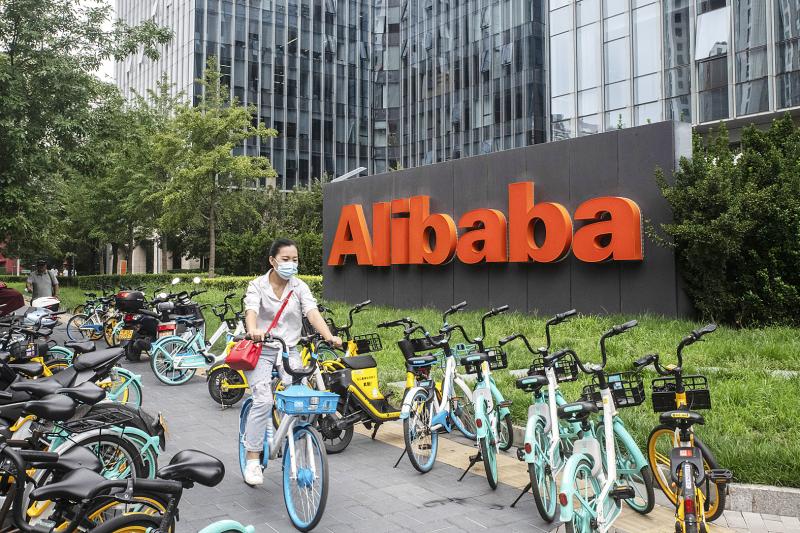After helping more than 1 million brick-and-mortar Chinese retailers modernize their operations, Alibaba Group Holding Ltd (阿里巴巴) has now set its sights on a new target: the country’s outdated factories.
China’s largest corporation in September unveiled its first smart factory, a secret experiment that Alibaba has been conducting for three years on the outskirts of its hometown, Hangzhou.
The three-story facility known as Xunxi (迅犀) — translated literally as “fast rhino” — is the company’s attempt at leveraging its consumer data and technologies to help the multitrillion-dollar manufacturing arena improve in efficiency and meet rising consumer expectations.

Photo: Bloomberg
Alibaba’s path to smart manufacturing starts with garments, a market worth 2.2 trillion yuan (US$328 billion) in China last year based on Euromonitor International’s estimates.
The company has said that one in four clothes purchases in the country was shipped via its e-commerce platforms, granting it access to an ocean of data that it is now deploying to assist domestic garment makers in design and production planning.
It is also centralizing the material procurement process to help reduce costs. Artificial intelligence (AI), robotic arms as well as many other in-house technologies have also been put into use at the Xunxi factory prototype.
It usually takes months for apparel companies to bring a new design from the runway to stores, but Alibaba claims it is able to cut order lead times by 75 percent with its solutions.
For instance, with the help of AI, designers can review simulated rendering effects on so-called digital fabrics on their computer screens, rather than going through a time-consuming process to dye the fabric.
Garment workers at the factory have high-tech assistants, such as AI-enabled cutting machines and Internet-connected sewing devices, that help fine-tune their work.
Once a step has been completed, the item would be transferred to the next work station via a conveyor belt. As the entire workflow is recorded digitally, factory management no longer has to stay on site. Instead, they can track the progress remotely on computers or through their mobile phones.
The data and technology deployed at the Xunxi factory mean merchants, which typically need at least 90 days to get their goods ready for the storefront, can decide what items to make and the scale of the production over the course of two weeks, reducing the need to accumulate inventory.
Its ultimate goal is to become a one-stop production solution provider for garment merchants on its Taobao (淘寶) and Tmall (天貓) marketplaces, Alibaba said.
Separately, Huawei Technologies Co (華為) plans to build a chip plant in Shanghai without using US technology, the Financial Times reported.
The fabrication facility is expected to start with the manufacture of low-end 45-nanometer chips, the paper said yesterday, citing people familiar with the project.
Huawei aims to make 28-nanometer chips for “Internet of Things” devices by the end of next year, and produce 20 nanometer chips for 5G telecom equipment by late 2022, the report said.

Semiconductor shares in China surged yesterday after Reuters reported the US had ordered chipmaking giant Taiwan Semiconductor Manufacturing Co (TSMC, 台積電) to halt shipments of advanced chips to Chinese customers, which investors believe could accelerate Beijing’s self-reliance efforts. TSMC yesterday started to suspend shipments of certain sophisticated chips to some Chinese clients after receiving a letter from the US Department of Commerce imposing export restrictions on those products, Reuters reported on Sunday, citing an unnamed source. The US imposed export restrictions on TSMC’s 7-nanometer or more advanced designs, Reuters reported. Investors figured that would encourage authorities to support China’s industry and bought shares

TECH WAR CONTINUES: The suspension of TSMC AI chips and GPUs would be a heavy blow to China’s chip designers and would affect its competitive edge Taiwan Semiconductor Manufacturing Co (TSMC, 台積電), the world’s biggest contract chipmaker, is reportedly to halt supply of artificial intelligence (AI) chips and graphics processing units (GPUs) made on 7-nanometer or more advanced process technologies from next week in order to comply with US Department of Commerce rules. TSMC has sent e-mails to its Chinese AI customers, informing them about the suspension starting on Monday, Chinese online news outlet Ijiwei.com (愛集微) reported yesterday. The US Department of Commerce has not formally unveiled further semiconductor measures against China yet. “TSMC does not comment on market rumors. TSMC is a law-abiding company and we are

FLEXIBLE: Taiwan can develop its own ground station equipment, and has highly competitive manufacturers and suppliers with diversified production, the MOEA said The Ministry of Economic Affairs (MOEA) yesterday disputed reports that suppliers to US-based Space Exploration Technologies Corp (SpaceX) had been asked to move production out of Taiwan. Reuters had reported on Tuesday last week that Elon Musk-owned SpaceX had asked their manufacturers to produce outside of Taiwan given geopolitical risks and that at least one Taiwanese supplier had been pushed to relocate production to Vietnam. SpaceX’s requests place a renewed focus on the contentious relationship Musk has had with Taiwan, especially after he said last year that Taiwan is an “integral part” of China, sparking sharp criticism from Taiwanese authorities. The ministry said

US President Joe Biden’s administration is racing to complete CHIPS and Science Act agreements with companies such as Intel Corp and Samsung Electronics Co, aiming to shore up one of its signature initiatives before US president-elect Donald Trump enters the White House. The US Department of Commerce has allocated more than 90 percent of the US$39 billion in grants under the act, a landmark law enacted in 2022 designed to rebuild the domestic chip industry. However, the agency has only announced one binding agreement so far. The next two months would prove critical for more than 20 companies still in the process